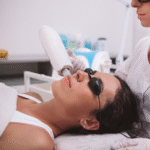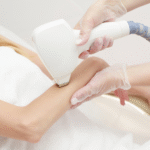Stretch Marks and Cellulite Difference Explained Simply and Clearly
- Home
- Mole, Wart & Skin Tag Removal
- stretch marks and cellulite difference

Cellulite and stretch marks are distinct skin conditions. Cellulite appears as dimpled skin, often on thighs and buttocks, due to fat deposits pushing against weakened collagen and elastin fibers in the subcutaneous tissue. Stretch marks, or striae, manifest as linear scars resulting from rapid stretching and subsequent tearing of dermal fibers. Unlike cellulite, which concerns fat and connective tissue interaction, stretch marks stem from dermal overstretch. Further exploration reveals stretch mark treatment and prevention strategies.
Key Takeaways
- Cellulite appears as a dimpled texture, while stretch marks are linear scars on the skin.
- Cellulite results from fat deposits pushing against connective tissue beneath the skin.
- Stretch marks occur due to rapid stretching and tearing of the dermal layers.
- Cellulite is more common in women due to hormonal and genetic factors.
- Stretch marks are linked to rapid skin changes during puberty, pregnancy, or weight fluctuations.
What is Cellulite?
Cellulite is characterized by a dimpled, lumpy appearance on the skin, primarily occurring in areas such as the thighs, buttocks, and abdomen.
Its formation is attributed to factors such as genetic predisposition, hormonal fluctuations, and lifestyle influences like diet and physical activity levels, which affect the fibrous bands that anchor the skin to the muscle beneath.
Treatment modalities for cellulite range from topical agents and mechanical devices to more invasive procedures like laser therapy and subcision, each with varying levels of efficacy and scientific backing.
How Does Cellulite Appear?
Beneath the surface of the skin, cellulite manifests as a distinctive dimpling or nodular texture, primarily affecting areas like the thighs, buttocks, and abdomen.
This appearance of cellulite is attributable to the interaction between fat cells and connective tissue. As fat cells accumulate and expand, they push against the skin while the fibrous connective tissue pulls downward. This tension results in the characteristic dimpled appearance, often described as resembling “orange peel” or “cottage cheese.”
The skin texture is further influenced by collagen and elastin fibers, which provide structural support but may weaken over time.
Additionally, factors like weight gain exacerbate the visibility of cellulite by increasing the volume of subcutaneous fat, intensifying the contrast between skin and underlying structures.
What Are the Common Causes of Cellulite?
The distinct appearance of cellulite is influenced by several underlying causes that contribute to its formation.
Many factors explain why women have cellulite more commonly than men. Cellulite involves the interaction between fat deposits and connective tissue beneath the skin. As the skin stretches, fat cells push through the fibrous connective tissue, causing cellulite to appear as a dimpled surface.
This skin condition is prevalent in women; hormonal factors and genetic predispositions make women more susceptible to developing cellulite.
The structural integrity of collagen fibers in the skin also plays a significant role; weakened collagen allows for more pronounced fat protrusions.
In addition, age-related changes in skin elasticity and thickness exacerbate its visibility.
Understanding the causes of cellulite, including the anatomical and physiological interactions, is vital to exploring strategies to reduce the appearance of this common dermatological concern.
How Can Cellulite Be Treated?
Emerging from the complex interplay of skin structure and adipose tissue, cellulite presents a challenging dermatological condition that can be managed using a range of treatment options.
Laser therapy serves as a prominent cellulite treatment, employing thermal energy to target and disrupt subcutaneous fat, thereby aiding in cellulite reduction and improving skin texture. Additionally, this method stimulates collagen production, reinforcing connective tissue to reduce the visibility of cellulite and stretch marks.
Other treatment options include radiofrequency and acoustic wave therapy, which enhance microcirculation and facilitate cellulite removal. Topical treatments with retinoids may also improve the appearance of cellulite by increasing skin elasticity.
While complete cellulite eradication remains elusive, these evidence-based strategies offer viable means to get rid of cellulite and refine skin contour.
What are Stretch Marks?
Stretch marks, also known as striae, are dermal scars characterized by linear bands of atrophied skin that occur due to rapid stretching of the dermis.
The aetiology of stretch marks involves factors such as corticosteroid use, pregnancy, and genetic predisposition, which disrupt the structural integrity of collagen and elastin fibers.
Current treatment modalities for stretch marks include topical retinoids, laser therapy, and microneedling, each aimed at enhancing collagen synthesis and improving skin texture.
How Can We Understand Stretch Marks?
Why do stretch marks occur, and what exactly are they?
Stretch marks are linear scars that manifest due to the tearing of the dermis, the resilient connective tissue beneath the skin. This tearing is often linked to rapid skin stretching during growth spurts, which disrupts normal collagen production.
Collagen, a critical protein, guarantees skin tissue elasticity and strength. The initial appearance of stretch marks is typically red or purple, indicating recent development. Over time, they fade to a lighter hue.
Although harmless, many seek treatment options for stretch marks to improve skin appearance. Current methodologies aim to stimulate collagen production and enhance skin texture.
Understanding the underlying mechanisms of developing stretch marks informs more effective interventions tailored to individual needs.
What Causes Stretch Marks?
Understanding the formation of stretch marks involves examining the underlying factors contributing to their development.
Stretch marks, medically referred to as striae, Stretch marks are a common skin condition marked by streak-like lines on the dermis, primarily caused by the skin stretching rapidly, which results in the tearing of the dermal connective tissue.
This tearing disrupts collagen and elastin fibers, essential components that provide structural support and elasticity. Consequently, this disruption leads to the appearance of stretch marks.
These marks are common during periods of significant growth or hormonal changes, such as puberty, pregnancy, or rapid weight fluctuations.
Genetic predisposition and certain medical conditions stretch marks may exacerbate the likelihood of stretch mark development, making them a frequent dermatological concern.
What Treatment Options Are Available for Stretch Marks?
Addressing the treatment options for stretch marks involves exploring various strategies that aim to reduce their visibility and improve skin texture. Topical treatments, such as stretch mark creams containing hyaluronic acid, are employed to hydrate the skin and potentially improve the appearance of stretch marks. For more pronounced results, laser treatment is utilized to promote collagen production and aid in the removal of white stretch marks.
Treatment Option | Mechanism | Benefits |
Stretch Mark Creams | Hydration via hyaluronic acid | Improved skin texture |
Laser Treatment | Collagen stimulation | Reduction in white stretch marks |
Hyaluronic Acid | Skin elasticity enhancement | Overall appearance improvement |
Each method targets different aspects of skin repair, and combining treatments is often recommended to remove stretch marks effectively.

What’s the Difference Between Stretch Marks and Cellulite?
Stretch marks, known as striae, are linear scars that result from the rapid stretching of the skin, often due to pregnancy, growth spurts, or considerable weight changes, causing the dermis to tear.
In contrast, cellulite is characterized by the dimpled appearance of the skin, primarily in the thigh and buttock regions, resulting from fat deposits pushing through the connective tissue beneath the skin.
While both conditions can coexist in the same individual, their etiologies and manifestations differ considerably, necessitating distinct approaches to treatment and management.
Difference Between Stretch Marks and Cellulite
While both stretch marks and cellulite can affect the skin’s appearance, they represent distinct dermatological phenomena with differing etiologies and characteristics. Stretch marks often appear as linear scars due to rapid skin stretching, such as during pregnancy or growth spurts. Conversely, cellulite manifests as dimpled skin caused by subcutaneous fat deposits pushing against connective tissue. The difference between cellulite and stretch marks lies in their origin and presentation. Treatments to reduce the appearance of stretch marks involve topical retinoids or laser therapy, whereas developing cellulite may be managed with methods like massage or radiofrequency. Understanding the distinction between cellulite and stretch marks is essential for effective stretch marks and cellulite treatment strategies.
Feature | Stretch Marks | Cellulite |
Appearance | Linear, scar-like | Dimpled, uneven |
Primary Cause | Skin stretching | Subcutaneous fat deposits |
Common Locations | Abdomen, thighs | Thighs, buttocks |
Treatment Options | Topical retinoids, laser therapy | Massage, radiofrequency |
Occurrence | Rapid growth or weight change | Genetic, hormonal factors |
How Cellulite and Stretch Marks Develop
Understanding the distinct mechanisms behind the development of stretch marks and cellulite is essential for comprehending their differences.
Stretch marks often arise from rapid skin stretching, typically during pregnancy or growth spurts, causing dermal tearing. The microtrauma leads to scar-like formations, making stretch marks appear as discoloured streaks on the skin.
In contrast, cellulite occurs due to subcutaneous fat protruding through the connective tissue, resulting in a dimpled skin surface. The development of cellulite is influenced by factors such as hormonal changes, genetic predisposition, and lifestyle.
This structural alteration leads to the characteristic appearance of cellulite. It’s important to note that stretch marks are different their appearance is caused by the tearing of the skin’s deeper layers due to rapid stretching. The appearance of both cellulite and stretch marks is influenced by different physiological processes, highlighting the distinct difference between cellulite and stretch marks.
Can You Have Both Stretch Marks and Cellulite?
Curiously, individuals can indeed have both stretch marks and cellulite simultaneously, as they result from distinct physiological processes.
The difference between stretch marks and cellulite difference lies in their formation; stretch marks occur due to rapid skin stretching, damaging the dermal layer, while cellulite results from subcutaneous fat protruding into the dermis, causing a dimpled appearance.
The difference between stretch marks and cellulite is evident in their manifestations; stretch marks appear as linear scars, whereas a lumpy texture characterizes the appearance of cellulite.
Cellulite can occur regardless of body type, and both phenomena can be present in the same individual.
Although cellulite prevention strategies, such as maintaining a healthy lifestyle, may help, the stretch marks vs cellulite debate remain due to their distinct etiologies.
Effective Treatment Options for Stretch Marks and Cellulite
Laser treatments, such as fractional laser therapy, have shown efficacy in improving the appearance of both stretch marks and cellulite by stimulating collagen production and promoting skin remodeling.
Topical creams containing retinoids and hyaluronic acid, alongside collagen supplements, can aid in skin elasticity and repair by enhancing dermal collagen synthesis.
Additionally, a combination of diet and exercise has been demonstrated to reduce cellulite by decreasing subcutaneous fat and improving muscle tone, thereby altering the skin’s contour and texture.
Laser Treatment for Stretch Marks and Cellulite
Advancements in dermatological technology have introduced laser treatment as a promising intervention for addressing both stretch marks and cellulite. Laser treatment utilizes focused light energy to penetrate the skin, stimulating collagen production and restructuring the dermis. This process can effectively reduce the appearance of stretch marks and treat cellulite by improving skin texture and elasticity. While these treatments are not harmful, they do not eliminate cellulite or stretch marks but greatly improve their visibility.
Aspect | Effect of Laser Treatment |
Stretch Marks | Reduces the appearance |
Cellulite | Improves appearance of cellulite |
Collagen Stimulation | Increases production |
Skin Elasticity | Enhances texture |
Long-term Outcome | Marks can appear less pronounced |
Through these mechanisms, laser treatments offer a viable option for those seeking to reduce unwanted skin irregularities.
Topical Creams and Collagen Supplements
Topical applications and collagen supplements present themselves as viable non-invasive options for managing stretch marks and cellulite.
Topical creams, often containing retinoids, hyaluronic acid, or caffeine, have been shown to improve skin elasticity and reduce the appearance of stretch marks. These creams work by promoting dermal remodeling, which helps address the difference between cellulite and stretch marks.
On the other hand, collagen supplements aim to enhance dermal strength and elasticity from within, providing structural support to reduce the appearance of cellulite.
It is important to note that although stretch marks are not harmful, their aesthetic impact often prompts treatment. While marks and cellulite are two distinct conditions, both benefit from interventions targeting skin health and resilience.
These approaches underscore the importance of targeted treatment strategies.
Diet and Exercise for Cellulite Reduction
While topical treatments and supplements play a significant role in managing stretch marks and cellulite, dietary and exercise interventions offer another layer of effective treatment.
A balanced diet rich in antioxidants and anti-inflammatory foods can aid in cellulite reduction by improving skin elasticity and reducing inflammation.
Exercise, particularly strength training and aerobic activities like running or cycling, can help tone the thigh and buttock regions, where cellulite commonly appears.
Cellulite vs stretch marks: cellulite includes dimpled skin caused by fat deposits, while stretch marks are also dermal scars that often appear red or purple.
Both conditions benefit from increased muscle tone and reduced body fat, achieved through targeted exercise.
Consistent dietary adjustments and physical activity may mitigate the appearance of cellulite and enhance overall skin health.

How to Prevent Stretch Marks and Cellulite
Preventing stretch marks and cellulite involves maintaining healthy skin tissue through the optimization of collagen and elastin production, which are critical proteins for skin elasticity and strength.
Scientific studies suggest that a balanced diet rich in vitamins C and E, as well as zinc, supports the synthesis of these proteins, thereby enhancing skin resilience.
Additionally, regular physical activity and hydration are essential lifestyle choices that may reduce subcutaneous fat deposits, further minimizing the likelihood of cellulite formation.
Maintaining Healthy Skin Tissue
Healthy skin maintenance is essential for minimizing the risk of developing stretch marks and cellulite. Both conditions, though distinct in their aetiology, share some preventative strategies.
Stretch marks are two forms of scarring caused by rapid skin stretching, while cellulite involves subcutaneous fat protrusion. Understanding the difference is vital for targeted interventions.
Regular hydration supports skin elasticity, aiding in cellulite and stretch mark removal efforts. Nutritional balance, including vitamins A, C, and E, enhances skin resilience.
Exercise improves circulation, reducing fat accumulation like cellulite. Meanwhile, topical treatments may explore the differences between cellulite and stretch marks, offering targeted solutions.
Awareness of the history of stretch marks underscores the importance of preventive care while ongoing research continues to refine effective strategies.
Role of Collagen and Elastin in Skin Health
Collagen and elastin are fundamental proteins in maintaining skin integrity, playing important roles in preventing the formation of stretch marks and cellulite.
Collagen provides structural support, enhancing tensile strength, while elastin imparts elasticity, allowing skin to return to its original shape after stretching. Insufficient collagen and elastin can lead to dermal disruptions. Preventing their degradation is essential to mitigating skin damage.
- Collagen Synthesis: Vitamin C and amino acids are crucial for collagen synthesis, fortifying dermal layers.
- Elastin Preservation: UV exposure degrades elastin; photoprotection via sunscreen is important.
- Hydration: Adequate moisture maintains skin flexibility, aiding in structural resilience.
- Antioxidant Intake: Antioxidants counteract oxidative stress, protecting collagen and elastin fibers from breakdown.
Enhancing these proteins’ production and preservation is key to reducing the risk of stretch marks and cellulite.
Healthy Lifestyle Choices to Prevent Fat Deposits
Adopting a balanced diet and regular exercise regimen effectively minimizes the risk of developing stretch marks and cellulite by influencing body composition and skin health.
A diet rich in antioxidants, vitamins, and minerals supports collagen synthesis and skin elasticity, consequently enhancing dermal resilience. Omega-3 fatty acids, found in fish and flaxseeds, reduce inflammation, promote skin integrity and reduce fat deposits.
Concurrently, resistance and cardiovascular exercises improve muscle tone and circulation, facilitating subcutaneous fat reduction. Hydration is essential, as water maintains skin turgor and elasticity.
Additionally, regulating body weight through caloric balance prevents rapid skin stretching, a precursor to stretch marks. As a result, these lifestyle interventions collectively create a physiological environment less conducive to the formation of stretch marks and cellulite.
Conclusion
In conclusion, while both stretch marks and cellulite affect skin appearance, they differ in origin and characteristics. Stretch marks arise from skin stretching and tearing, forming linear scars, often due to rapid growth or hormonal changes. Conversely, cellulite results from fat deposits beneath the skin, creating a dimpled texture. Effective treatments include topical retinoids for stretch marks and laser therapies for cellulite. Preventative measures emphasize maintaining a healthy weight and skin hydration, supported by evidence-based research on skin elasticity and collagen preservation.

Highly skilled cosmetologist at Tune Clinical Aesthetics, specializing in advanced skin and hair treatments.





